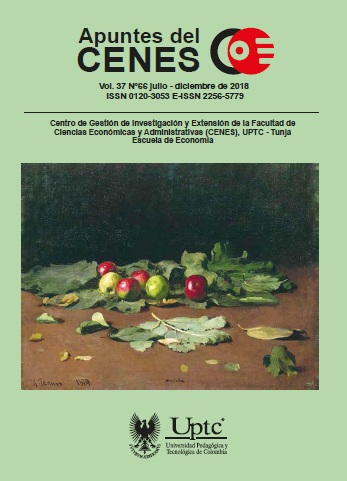Spatial Patterns of Agriculture in Boyacá

Abstract
This article figures out spatial patterns for Boyacá’s agriculture and exposes the behavior of production. Applying gravitational concepts we describe relevant spatial interactions across municipalities using
variables as population, output and linear distances. We perform an econometric model for detecting the class of spatial dependence showed by agricultural output as endogenous using as arguments distance to
Tunja and rural population. We deploy standard tools of spatial analysis and empirical strategies for identify clusters of towns according with their performance and productivity. Statistical contrast indicates that the most suitable scheme for describing spatial dependence in production is spatial lag model. Econometrics conveys important clues demonstrating that higher scales output is conducted to urban national markets and output produced with scarce scales is sold locally in local towns. A strong subjacent idea is that lagged municipalities are badly influenced by geographical isolation and high transportation costs do hinder the social and economic development in Boyacá.
Keywords
gravity model, agricultural production, productive structure, spatial interaction, spatial econometrics
References
- Anderson, J. (2010). The Gravity Model. Working Paper 16576. Cambridge, MA: National Bureau of Economic Research. https://doi.org/10.3386/w16576 DOI: https://doi.org/10.3386/w16576
- Anselin, L. (2001). Spatial Econometrics. In B. Baltagi (ed.), Companion to Theoretical Econometrics (pp. 310-330). Oxford: Blackwell Publishing. DOI: https://doi.org/10.1002/9780470996249.ch15
- Arfa, N., Rodríguez, C., Daniel, K. & Shonkwiler, S. (2010, March 10-11). Spatial Structure of Agricultural Production in France. In OECD Workshop on the Disaggregated Impacts of CAP Reform.
- Arias, H. & Antosova, G. (2015). Perfil espacial de la economía boyacense. Revista Apuntes del Cenes, (59).
- Asohofrucol. (2013). Plan de negocios de cebolla. Bogotá: Asohofrucol.
- Bernat, A. (1996). Does Manufacturing Matter? A Spatial Econometric View of Kaldor’s View. Journal of Regional Science, 36(3), 463-477. https://doi.org/10.1111/j.1467-9787.1996.tb01112.x DOI: https://doi.org/10.1111/j.1467-9787.1996.tb01112.x
- Bongiovanni, R. (2009). Econometría espacial aplicada a la agricultura de precisión. Actualidad Económica, (67).
- Chasco, C. (2003). Métodos gráficos del análisis exploratorio de datos espaciales. Anales de economía aplicada. Almería, España: Asociación Española de Economía Aplicada.
- De Noronha, E. & De Noronha, T. (2010). Gravitational Models and Spatial Foresight: From Agricultural Policy to Agricultural Loss. Advances in Urban Rehabilitation and Sustainability, 124–127.
- DNP (2007). Agenda Interna para la Productividad y la Competitividad. Documento Regional: Boyacá. Bogotá.
- Dubin, R. (1998). Spatial Autocorrelation: A Primer. Journal of Housing Economics, 7, 304-327. https://doi.org/10.1006/jhec.1998.0236 DOI: https://doi.org/10.1006/jhec.1998.0236
- Duranton, G. & Overman, H. (2005). Testing for Localization Using Micro-Geographic Data. Review of Economic Studies, 72(4), 1077-1106. https://doi.org/10.1111/0034-6527.00362 DOI: https://doi.org/10.1111/0034-6527.00362
- Elhorst, J. (2010). Applied Spatial Econometrics: Raising the Bar. Spatial Economic Analysis, 5(1), 9-28. https://doi.org/10.1080/17421770903541772 DOI: https://doi.org/10.1080/17421770903541772
- Fedepapa & Ministerio de Ambiente, Vivienda y Desarrollo Territorial. (2004). Guía ambiental para el cultivo de la papa. Bogotá: Fedepapa.
- Gobernación de Boyacá. (2012). Plan Departamental de Desarrollo 2012-2015: Boyacá se atreve. Tunja: Gobernación de Boyacá.
- Gobernación de Boyacá. (2014). Informe de ejecución: Plan Departamental de Desarrollo 2012-2015: Boyacá se atreve. Tunja: Gobernación de Boyacá.
- Helsen, J. (2008). Essays on the Spatial Analysis of Manufacturing. Ph. D. Dissertation Ken State University. Graduate School of Management.
- Isard, et al. (1998). Methods of Interregional and Regional Analysis. Ashgate: Aldershot.
- Krugman, P. (1991). Increasing Returns and Economic Geography. Journal of Political Economy, 99. https://doi.org/10.1086/261763 DOI: https://doi.org/10.1086/261763
- Krugman, P. (1992). Geografía y comercio. Barcelona: Antoni Bosch.
- Krugman, P. (1995). Desarrollo, geografía y teoría económica. Barcelona: Antoni Bosch.
- Krugman, P. (2008). The Increasing Returns Revolution in Trade and Geography. Nobel Prize. Lecture. Stockholm. Retrieved from www.nobelprize.org
- Ministerio de Agricultura y Desarrollo Rural & IICA (1997). Instrumentos, mecanismos e institucionalidad para la comercialización de productos agrícolas en Colombia. Bogotá: Minagricultura.
- Moreno, R. & Vayá, E. (2002). Econometría espacial: nuevas técnicas para el análisis regional. Una aplicación a las regiones europeas. Investigaciones Regionales, 1, 83-106.
- Plan Frutícola Nacional –PFN- (2006). Desarrollo de la fruticultura en Boyacá. Tunja: s.n.
- Proexport. (2014). La Revista de las Oportunidades. Boyacá. Bogotá: Proexport.
- Rodríguez, L. & Bermúdez, L. (1997). Bases para el estudio de la competitividad de la producción de papa de las agroempresas campesinas de la región central de Boyacá. Agronomía Colombiana, 14(1).
- Secretaría de Fomento Agropecuario. (s.f.). Política agropecuaria departamento de Boyacá. Con Visión 2020. Tunja: Gobernación de Boyacá.
- Superintendencia de Industria y Comercio. (s.f.). Cadena productiva de la papa: diagnóstico de la libre competencia. Bogotá: SIC.
- Tobler, W. (1975). Spatial Interaction Patterns. IIASA Research Report. Luxembourg.
